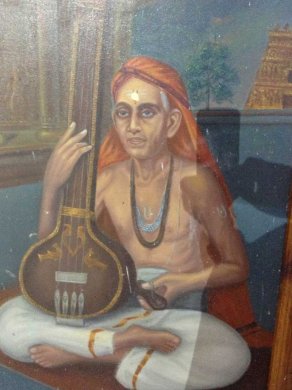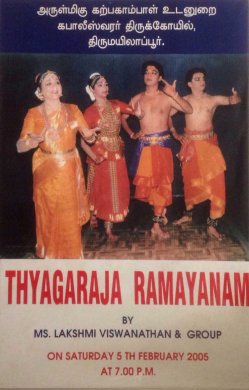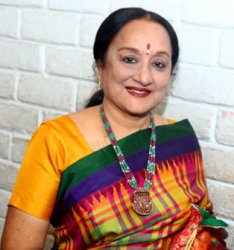
|   |

|   |
Nine steps to visualising Tyagaraja kritis May 12, 2017  I belong to a Thanjavur ancestry. Therefore, the songs of Tyagaraja were literally the melodies I woke up to. My mother Alamelu Viswanathan sang and played them on the veena as her personal offering to Rama. She taught us some famous kritis, which have stayed with me ever since. I remember both myself and my sister Sujaya singing some of the easier songs at Golus during Navarathri. Learning vocal music from a young age created a singing repertoire for me, which was rich in range: from the demanding Pancharatnas to the evocative poems in melodious ragas of which Tyagaraja was the exclusive master. But listening to great singers was an even more enlightening experience. I used to marvel at the torrent of "sangathis" in some kritis and enjoy the variety of ragas. With the early foundations laid by great gurus like Kanjivaram Ellappa, I understood dance as visual music. After years of mastering and performing the traditional pieces of Bharatanatyam, I took up the challenge of enlarging my repertoire with other music that is inspirational. An exclusive performance based on Tyagaraja's compositions, a special programme for Doordarshan in 1986 made me go deep into a study of chosen compositions. The work was pure pleasure, and the result, amazing. The rare Harikambodhi piece "Sri Raghuvara" with swaras and sahithya proved to be an engaging opener. I composed dance for the kriti "Ksheerasagara sayana" in Devagandhari. The way Tyagaraja weaves mythology into his songs with just a few words gives scope for elaborations with the phrases repeated in a variety of sangathis. With subtlety and suggestive abhinaya I wove the episodes of Gajendra moksha and of Draupadi into the dance choreography with telling effect. Taking a few phrases and elaborating on the theme is what abhinaya is all about. It is thus that I embarked on bringing out episodes of the Ramayana using appropriate Tyagaraja kritis. A challenging task in the beginning, it slowly evolved into an exercise of pure musical exploration and indulgence of imagination. With "Ela nee dayaradha" (Bala Kanakamaya) in Atana ragam, I introduced the child Rama and his siblings, gliding into the portrayal of their gurukula vasam. Artistic license is a permissible luxury in dance interpretation. One has to tread carefully though, knowing that many in the audience may be Tyagaraja experts. However, my creative impulses had to be used, given such an opportunity to explore the works of a great composer. I had to unfold the salient episodes of the Ramayana with the little nuggets provided by Tyagaraja. They are really hidden treasures. The story goes that Tyagaraja composed "Nannupalimpa" in Mohana ragam, seeing his brother walking towards him with a picture of Rama. In my visualisation, the words, "Na prana nadha" evoked the feelings of Sita when she first set her eyes on the young Rama entering Mithila. That is exactly what I portrayed in my dance ....not only the jump in Sita's heart when she saw Rama, but also the stillness and utterly mesmerised reaction of every woman in Mithila who set her eyes on Rama. One cannot find Tyagaraja dwelling at length on any Ramayana episodes. Sometimes a single phrase by its sheer beauty of rendition can touch your mind. One such is the way D.K. Pattammal used to sing the kriti "Sri Rama Padama" in ragam Amrithavahini. The amazing soulfulness in the mingling of music and lyrics in the phrase "soora Ahalyanu joochi brochithivi" moved me to choreograph this kriti with the episode of Ahalya moksham coming to the fore. In the kriti in Madhyamavathi ragam, "Nadhupai," a certain phrase caught my imagination. It is "Ajanubahuyuga Sri Janaki pathi," descriptive of Rama's long, well built arms. In a demonstration at the Music Academy, with my sister Charumathi Ramachandran doing a perfect nereval of Ajanubahu, I danced a detailed description of not only the majestic Rama and his valorous persona, but also wove into it the entire episode of the Sita swayamvaram, culminating in Rama lifting the bow of Shiva effortlessly. As I recall, the expert of the day K. Chandrasekara Iyer commented in a pithy manner: "This was worthy of a Bala." A rare kriti is "Vachamakochara" in the ragam Kaikavasi. Nobody can sing it with the verve and vigour of M.S. Subbulakshmi. Looking for a suitable song with a phrase to elaborate the Maricha episode, I found this gem. Using instruments to do the neraval, I could build on the moods of Sita, her falling prey to deception, and her abduction at the hands of Ravana.  Attracted by the simple lyrics and the plaintive tune prompted me to use "Nannu vidachi" in the ragam Rithigowla, and transpose it from the pathos of Prahlada to the plight of Sita in the Ashoka Vanam. It worked beautifully. So did "Eti janmam" in the ragam Varali. The lyrics of Tyagaraja and the ragams that he has used are the delight of a connoisseur. He has melded raga and bhava in a golden mesh that it became inevitable for me to weave the soul of abhinaya into the pattern. I recall Maharajapuram Santhanam attending this Tyagaraja Ramayana performance of mine and remarking later: "Those kritis will never be the same again for me." Having shared my nine steps to visualise Tyagaraja kritis, I must point out that it is possible to dance to many of them, provided the dancer can evoke a chord of devotion to Rama. Tyagaraja sings with an intimacy that is both moving and poetic, quite like the songs of Bhadrachala Ramadas. The plaintive bhakti, the longing of the jeevathma for the paramathma creates a certain mood worthy of mature abhinaya. On the other hand, it is difficult to dance to the Pancharatna kritis. The one that I chose to dance is "Sadinchene" in Arabhi ragam, largely because the theme is based on Krishna, the playful lover. The sub-text of Tyagaraja kritis is spiritual. Bhakti bhava reigns supreme. However, if one studies the songs carefully one can find a myriad moods which are useful for portraying the Nava Rasas. With this in mind I choreographed "Navarasa Sita" and enjoyed discovering many subtleties in the lyrics. One such is in the kriti in Kambodhi ragam, "Ma Janaki" where Tyagaraja alludes to Sita's anger at Ravana's advances. And when Hanuman jumps in as the saviour, what better jingling melody does one need than Tyagaraja's "Pahi Rama dhootha"! For me, a great source of inspiration has been the singing of the great masters of the twentieth century. They maintained not only the oral tradition of the sishya paramparas but also brought their own creativity to Tyagaraja's compositions. Some indeed will remain special because as true artists they have made an indelible impression on us with their individual touch. Here I must acknowledge the musicologist T.S. Parthasarathy whose book and personal interactions were invaluable. Exploring the lyrics of Tyagaraja and dwelling on his inimitable melodies is a dance journey worth undertaking. One may find many a pearl in this ocean, provided one dives deep. Tyagaraja's compositions for dance have the unique advantage of carrying the audience to a state of rasanubhava. After all, our audiences are largely familiar with his eternal melodies and certainly enjoy dance as visual music.  Lakshmi Vishwanathan, a prime disciple of Guru Kanjeevaram Elappa Pillai, is an exponent of the Thanjavur style of Bharatanatyam. She is also a trained vocalist. She is the author of several acclaimed books: Bharatanatyam - the Tamil Heritage, Kunjamma - Ode to a Nightingale, Kapaleeswara Temple, Women of Pride -The Devadasi Heritage. Her film 'The Poetry of Dance' was commissioned by the Festival of India. The Mamallapuram Dance Festival started in 1991 was Lakshmi's brainchild. She has served on several arts committees. She is the editor of Kalakshetra Journal. Post your comments Pl provide your name and email id along with your comment. All appropriate comments posted with name and email id in the blog will also be featured in the site. |